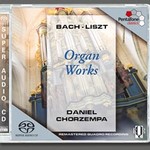
Organ Works (Incls 'Toccata & Fugue in D minor BWV565')
 $37.00
Out of Stock
$37.00
Out of Stock2-4 weeks add to cart
J.S. BACH
Organ Works (Incls 'Toccata & Fugue in D minor BWV565')
Daniel Chorzempa (organ)
[ Pentatone SACD / Hybrid SACD ]
Release Date: Sunday 4 May 2008
This item is currently out of stock. We expect to be able to supply it to you within 2 - 4 weeks from when you place your order.
"One would never realize listening to this first rate disc that the original recordings are over 30 years old...the lowest organ pipes sound forth with the beginning bass theme of the Passacaglia with room-shaking low end force." (AudAud.com)
Hybrid/SACD - playable on all compact disc players
"We have here another of the quadraphonic recordings Philips made in the early 1970s for possible commercial release on LP, but then realized the quad disc formats were really not viable and shelved the tapes. Until now, when the four channels on the tapes can be properly realized via multichannel SACD. One would never realize listening to this first rate disc that the original recordings are over 30 years old. Neither the center channel nor sub channel are missed in the least. In fact the lowest organ pipes sound forth with the beginning bass theme of the Passacaglia with room-shaking low end force. This is Bach's only organ work in the form of a Passacaglia.
The concluding 16-minute Liszt work is rarely heard and makes a good balance against the overplayed Toccata and Fugue in D minor. Liszt used just a bass line from the Bach cantata in his highly improvised-sounding variations. The theme serves as foundation for a passacaglia which becomes quite complex rhythmically. The work ends with a quote from the concluding chorale of the same Bach cantata. The recordings were made on pipe organs in two different Dutch churches, and the impression of the church acoustics is strong in both."
(AudAud.com ****)
Johann Sebastian Bach left behind compositions in just about every musical genre of the day - except for opera. Mainly due to the varying professional fields in which he worked, Bach gained access to new genres step by step. This enabled him during the course of his career to achieve a well-nigh incredible versatility, which is more than just an indication of the outstanding role he played in the history of music.
As far as the organ is concerned, one quite simply has to describe Bach as a genius - and in Bach's case, this is equally valid as far as his brilliant playing, his masterly composition and his intimate knowledge of the instrument are concerned. He was a master in both the intermingling and the perfecting of numerous diverging traditional styles. In his younger years - while he was still studying the organ with his brother Johann Christoph, and also during his appointments as organist in Arnstadt and Mühlhausen (1703-1708) - Bach examined all sources of music available to him with the greatest of intensity, to see how he could use and learn from them. Thus, he taught himself through studying works by composers from the south and middle of Germany, such as Froberger and Pachelbel, as well as those by composers from the north, such as Buxtehude. But he also interwove Italian and French musical styles into the composition of his organ works. The works recorded on this SACD are all so-called "free" organ works, in contrast to his chorale compositions.
The Toccata and Fugue in D minor, BWV 565 - probably written between 1704 and 1708 - is very likely the most popular organ composition ever composed by Bach. (If it was indeed written by Bach: there are doubts about the authenticity of this work to this day.) It demonstrates an impetuous youthfulness and insistent attitude, and is a stroke of utter genius. With its tempestuous unisono descending runs, its racing passage work and its agonizing diminished harmonies, it provides a fantastic mirror image of the possibilities offered by the instrument for virtuoso performance. The Fugue takes over the demanding, insistent character of the first movement (Adagio) and carries it forward to an abrupt end, before the outbursts of the Toccata-Coda finally return to peace and calm in a gigantic final cadenza. This work truly meets all demands made of "toccare i tasti", i.e. of "touching/playing the keys."
Tracks:
JOHANN SEBASTIAN BACH (1685 - 1750)
Toccata and Fugue in D minor, BWV 565
Passacaglia in C minor, BWV 582
Prelude and Fugue in D, BWV 532
Prelude and Fugue in A minor, BWV 543
FRANZ LISZT (1811-1886)
Variations on Bach's Cantata "Weinen, Klagen, Sorgen, Zagen," S179



